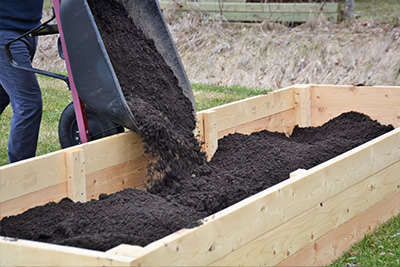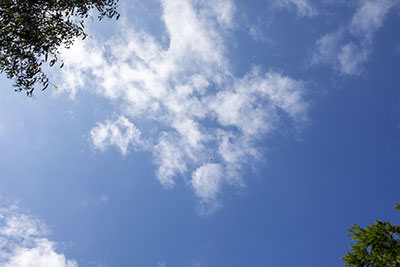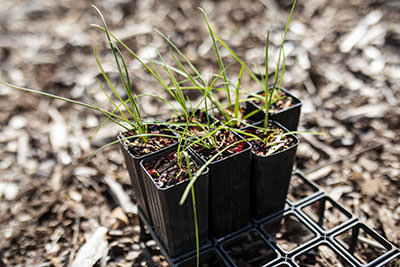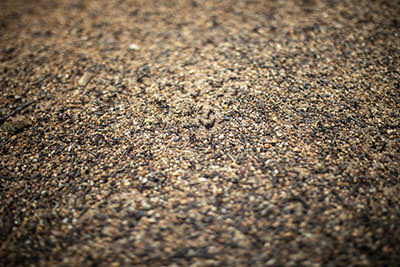LEARNING ACTIVITY
STORY
Jarrah and Adam have completed a site assessment for the new garden and prepared the site for planting. Jarrah has invited some of his friends to help him plant the garden. They have lots of fun planting and get it done in record time. They are all so happy and start to leave the garden.
Adam called “Jarrah! You’re not finished yet mate. Remember I told you these plants need a good water and some mulch around them for added protection and to keep the weeds at bay!” Jarrah called his friends back over and they got stuck in to the mulching and watering. The garden looked beautiful and they were all very proud of their achievements.

Planting out your garden is an exciting and fulfilling task. It is also a great opportunity to get your hands dirty and connect with nature.
To understand local perspectives and support these activities, we recommend reaching out to the local Traditional Owners and First Nations peoples community groups who can assist in knowledge sharing and understanding local land, histories and culture. This is an important consideration to ensure that any reconciliation initiatives are being driven in a local, meaningful way.
This learning activity is the fifth part of a sequence of 6 individual learning activities focused on creating an Indigenous plant- use garden. The order of these learning activities are: resources from the bush, vision, plant list, site assessment, planting and harvesting.
For children to:
- follow instructions and a planting plan
- understand the steps involved in planting out and maintaining a successful Indigenous plant-use garden
- enjoy being active and productive outdoors and build their social and teamwork skills
- physically be involved in the planting of the Indigenous plant-use garden develop a deeper understanding and appreciation of First Nations peoples culture through traditional use of native plants.
Planting is best done in a pre-prepared garden bed, either raised or worked over ground. Choose the plants from your plant list learning activity. During the warmer months (Spring, Summer and Autumn), it is recommended that you run this as a morning learning activity. This will help avoid heat stress for people and plants.
Introduction
Planting an Indigenous plant-use garden is a great way to learn about the importance of native plants to First Nations peoples. It is also an easy way to expand your diet in a way that incorporates foods that are native to this land and have been used by Aboriginal and Torres Strait Islander peoples for a very long time. The health benefits of these plants are becoming more widely understood so it is important for all Australians to start incorporating these foods in their cooking. Of course, many of these foods are extremely tasty as well!
Inviting the community to plant with the children is another opportunity to build relationships with the local First Nations peoples community (as well as other stakeholders in the school community such as parents and carers).
Prepare your garden area before planting. Refer to the site assessment learning activity to create the best conditions for your plant use garden.
*The time allocation for this activity is based on all materials being sourced prior to commencing the activity.
Checklist
Instructions
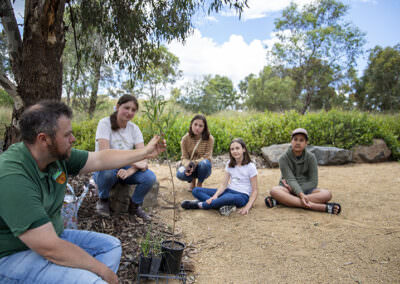
STEP 1
Plan
Begin this activity at your location with an Acknowledgement of Country. By acknowledging the Land, you are also making a promise that you will care for the Land, the waterways, the plants and the animals.
Following a plan is an important process when setting up your Indigenous plant-use garden. A plan will assist you to know where to plant certain plants to achieve the best results.
Go through your checklist to ensure you have all the materials needed.
Review the plan with the children before starting and outline the safety steps by asking them what would make this activity safe. Outline safe tool use.
Space out the pots onto the bare bed, discussing where they may go. Use your final design from the site assessment learning activity to help guide this. Refer to any planting information and plant labels to help guide the discussion.
Remember to consider how much space the plants need when fully grown. Will it shade other plants? Where do you think these plants should go?
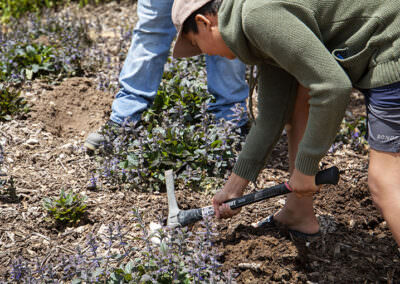
STEP 2
Prepare
Once the plants are in their correct positions, dig a hole that is slightly deeper and wider than the pot. Water the hole in preparation for planting.
Remove the plants from their pots ready for planting. It is best to have the least amount of disturbance to the roots as possible. Keep the soil and plant intact by gently squeezing each side of the pot, then place your hand flat over the soil with the stem between your fingers. This will provide the least amount of stress and disturbance to the plant during the process.
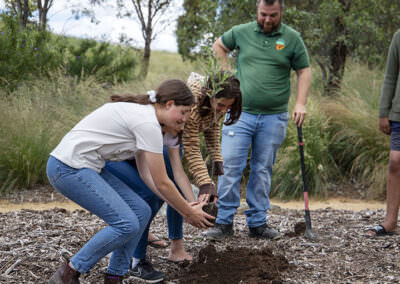
STEP 3
Planting
It is finally time to plant!
If the plant is going into new soil in a garden bed, you will need to dig a hole big enough to fit the plant and totally cover the roots. Press the soil around the plant gently without packing the soil too hard or too tight. Packing the soil hard will push the air out of the soil that is needed by the roots.
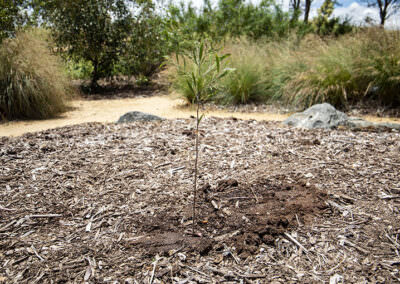
STEP 4
Maintenance and upkeep
Now that you have completed your planting, use the activity sheet to draw a map and listyour plants, include how many plants you have planted.
Create rosters and a task list to share the responsibility to care for your plants with your garden team. This can include watering, measuring growth and plant changes, checking mulch and looking for pests.
The more involvement and ongoing maintenance you put into the garden, the better the results you will have. It is important to respect this area and the significant plants that it holds.
Extension Activity
Extension 1
Now that you have planted out your Indigenous garden, design labels to create signage for the garden and the plants. What information will you include in your label? What information can you share regarding how First Nations peoples utilise this plant? Reach out to your local Traditional Owners and First Nations community groups to collaborate with.
Extension 2
Look at the range of plant forms you have in the garden and determine what quantities you have of each type. Do you have more shrubs than grasses? How many trees do you have? What might you need to plant more of in the future once the garden establishes?
Curriculum and Framework Links
Check the curriculum authority for your state or territory for Aboriginal and Torres Strait Islander specific subjects. This may also include training organisations.
GEOGRAPHY
Year 7: ACHGK045
Year 8: ACHGK049
Year 9: ACHGK061, ACHGK062, ACHGK064, ACHGK067
Year 10: ACHGK070, ACHGK071, ACHGK072, ACHGK076
HISTORY
Year 7: ACOKFH003, ACDSEH031
Year 9: ACDSEH085, ACDSEH020
DESIGN & TECHNOLOGIES
Years 7 & 8: ACTDEK032, ACTDEK033
SCIENCE
Year 7: ACSSU112, ACSSU116, ACSHE223, ACSHE121
Year 8: ACSHE134, ACSHE226
Year 9: ACSSU176
VISUAL ARTS
Years 7 & 8: ACAVAM118, ACAVAR124
Years 9 & 10: ACAVAM125, ACAVAR131
EARTH & ENVIRONMENTAL SCIENCES
Year 11: ACSES011, ACSES040
Year 12: ACSES066, ACSES077, ACSES081
BIOLOGY
Year 11: ACSBL011, ACSBL019, ACSBL020, ACSBL009, ACSBL011
GENERAL CAPABILITIES
Critical and Creative Thinking
Personal and Social Capability
Ethical Understanding
Intercultural Understanding
CURRICULUM CONNECTIONS
Outdoor Learning
CROSS CURRICULUM PRIORITY
Aboriginal and Torres Straight Islanders Histories and Cultures
Sustainability
Reference List
Complete the Whose Country are you on? learning activity to determine the local First Nations peoples language groups.
ONLINE RESOURCES
The Care for Country RAP (Reconciliation Action Plan) Action and Caring for country (Secondary) curriculum resource on the Narragunnawali platform provides resource material for students and teachers to build a personal sense of responsibility for respecting and caring for the Country/place around them, the while building an awareness and appreciation of Aboriginal and Torres Strait Islander contributions to sustainable land management
The Narragunnawali Reconciliation Garden Curriculum Resources provides tips on planting a Bush tucker garden.
WATCH
The many uses of indigenous plants (6 minutes) from ABC Education highlights the importance of plants in place and understanding their cultural significance and uses.
READ
Guide books for your local area.
Field guide to Useful native plants from temperate Australia, Judith Caton & Richard Hardwick, Harbour Publishing House, 2016 provides very useful visual information along with growing conditions and First Nations Peoples uses for plants in temperate areas.
This selection of books gives more detailed information on Australian native plants, their traditional uses and modern uses and recipes.
- The oldest foods on Earth, John Newton 2019 published by New South Publishing
- Grow your own bushfoods, Keith and Irene Smith, 2013 New Holland Publishers
- Australian Native Food Harvest, Julie Weatherhead, 2016 published by Peppermint Ridge Farm.
NETWORK
We recommend reaching out to the Local Traditional Owners and First Nations peoples community groups who can assist in knowledge sharing and understanding local land, language, stories and culture. To reach out or find contacts in your local community, you could speak to parents of First Nations students, to an Indigenous Learning Officer (ILO) at your school, local Land Council or a local Landcare group. Engaging with these resources can contribute to a wider school and community reconciliation initiatives, including a schools Reconciliation Action Plan (RAP).
We have some suggested organisations to approach listed on our Junior Landcare Community Page and in more detail within our Educator Notes.
Why not try one of our other Junior Landcare learning activities?
Creating an Indigenous plant-use garden: plant list
First Nations Perspectives
Creating an Indigenous plant-use garden: resources from the bush
First Nations Perspectives
Love Letters to the Land
Biodiversity|First Nations Perspectives|Food Production|Waste Management
Creating a yarning circle: involving First Nations people
First Nations Perspectives
